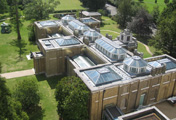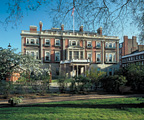Art for the Masses or Painting by the Yard (plus a delightful personal discovery)
Originally published in April 2014 in American in Britain - Spring 2014
The exhibition can be read as a movement about democratising art in the form of textile design and manufacture in the twentieth century. Established artists designed textiles which were mass produced, accessible and affordable for ordinary people. They revolutionised 20th century textile design and stimulated the production of fabrics which were sold in large quantities for clothing and interior furnishings.
Art for the Masses or Painting by the Yard (plus a delightful personal discovery)
By Abby Cronin
Did you know that Picasso designed textiles which sold for $1.50 a yard in the 1950s? Imagine owning a Picasso for a $1.50! I learned this and so much more when I visited the Artist Textiles exhibition at the Fashion and Textile Museum in Bermondsey –only a short walk around the corner from the Shard. Strictly, the exhibition is entitled Artist Textiles – Picasso to Warhol but the exhibit begins in the early years of twentieth century. ‘Curtain Up’ sets the scene from 1910 – 1939 and includes unique and sophisticated pieces by modernist artists involved in the art movements and workshops of the day. Visitors are introduced to work by Fauvist, Futurist, and Constructivist designers who had no doubt that designs for textiles are a legitimate and important form of artistic expression.
Among the many notable designers whose work is displayed are French artists Raoul Dufy and Sonia Delaunay. British painters Duncan Grant and Vanessa Bell, major figures in the Omega Workshop and Bloomsbury painters group, are well represented. Their work is shown alongside the Russian women Constructivists Popova and Stepanova. In the United States Ruth Reeves was an early and major proponent of the importance of textile design and her work on display reproduces indigenous patterns from extensive research into Guatemalan patterns. Reeves sums up her view about the importance of textile design as follows:
“It is my personal opinion that fabric design rightfully belongs in
the category of the Fine Arts,….as an art, it is just as important
as good architecture and certainly is more closely associated
with our everyday living than are paintings.” Ruth Reeves, 1946 *p.9
The exhibition can be read as a movement about democratising art in the form of textile design and manufacture in the twentieth century. Established artists designed textiles which were mass produced, accessible and affordable for ordinary people. They revolutionised 20th century textile design and stimulated the production of fabrics which were sold in large quantities for clothing and interior furnishings. The 200 textiles, fabrics, dresses and publicity information on display come from the extensive private collection of curators Geoff Rayner and Richard Chamberlain. For Rayner and Chamberlain artist textiles represent “art for the masses or painting by the yard….a democratisation of artists’ designs for mass production”.
In their post-war effort to rebuild the devastated economy, Britain recognised the potential for marketing textiles abroad as a strategy for promoting economic growth. The government-sponsored Cotton Board encouraged prominent textile manufacturers such as Ascher Ltd, Cresta Silks and Horrockes Fashions to market fabrics for export. These companies, in turn, persuaded renowned painters and sculptors to design a couture collection of headscarves and fashion fabrics. Floral headscarves by Chagall, Matisse and Vértes are displayed prominently. Dali’s compelling headscarf ‘Number, Please?’, featured on the museum’s exhibition poster, is a silk scarf for Wesley Simpson Fabrics circa 1947. It was derived from a sequence in Dali’s animation for Disney of 1946, Destino. You will see it hung at the end of the corridor as you enter the ground floor gallery. Dali’s inexhaustible output includes ties such as ‘Endless – Where?’ printed on rayon and ‘Spring Rain’, a furnishing fabric, just two of Dali’s numerous 1940s surrealist designs. Matisse’s headscarf design ‘Escarpe No. 1’ for Ascher Ltd. was exhibited at the Lefevre gallery in 1947. Fabric designs by Graham Sutherland and Eduardo Paolozzi were used by Horrockes in the dresses on display. Queen Elizabeth’s wardrobe included a selection of Horrockes dresses for her first tour of the Commonwealth in 1953-4. Horrockes Fashions ready-to-wear label was publicised as off the peg style in the ‘40s and ‘50s and conveniently coincided with the end of cloth allocation in Britain.
The American market in the 1940s and 50s was partial to modernist designs in the fabric of clothes and home furnishings. Magazines such as Vogue, Harpers Bazaar were influential in promoting modern art and design as an integral aspect of contemporary lifestyle. Several American textile manufacturers worked with established artists who sold their designs to companies – a marriage of art with commerce. Publications such as Women’s Wear Daily helped to promote artist-designed textiles. An example is the advertisement in 1947 which featured Wesley Simpson’s Custom Fabrics Inc., ‘Artist Series’ with deigns by Dali. Costumes and fashions in Hollywood films were also highly influential in shaping what was fashionable to wear – much as the TV series Sex in the City and Mad Men are today.
Perhaps the most prestigious collaboration between American textile companies with internationally renowned 20th century artists was when Dan Fuller of Fuller Fabrics Inc. gained Picasso’s cooperation in 1953. After a few years of painstaking collaboration between Picasso and the Fuller design team, Picasso’s designs were turned into roller printed fabrics enabling production on a vast scale.* When the designs went into production you could buy a yard of mass produced cotton fabric designed by Picasso for the modest sum of between $1.49 and $1.98. Orders came pouring in from garment manufacturers across the US and one of the distinguished companies who placed orders was Lanz of California. They produced dresses aimed for the teenage market which retailed for the modest sum of $20 a dress. There is a fabulous example of a Lanz dress in the exhibition—see it pictured here in red. Pictured next to it is my delightful personal discovery: Yes – that’s me wearing the same Lanz dress in the late 1950s. Oh how I loved that dress! Mine was blue. And Oh how surprised I was when I came across it featured prominently together with other designs by Picasso. Little did the American public realise that several off the peg 1950s fashions were made from fabrics designed by a galaxy of established artists such as Picasso.
Picasso had little need of publicity or money. Maybe that is why his name was not associated with the Lanz dresses made from his designs for Fuller Fabrics. However, much more publicity was associated with his famous ‘Peace Scarf’, a simple multiple printed design on inexpensive cotton –pictured here. Unusual and highly collectible, it was given away to youth at an international peace rally in Berlin in 1951 to commemorate the 3rd World Festival of Youth and Students in Berlin, East Germany. The festival’s motto was “For Peace and Friendship – Against Nuclear Weapons,” Inevitably it has appeared from time to time in art galleries over the years and one was sold for $7,980 in California in 2011.
Among the seminal textile designers in the art world of the 1950s and 60s are Zandra Rhodes, Andy Warhol, and Saul Steinberg. We have Rhodes to thank not only for hosting this exhibition but also for establishing the Fashion and Textile Museum which celebrated its 10th anniversary in 2013. A few examples of Rhodes’ 1960s designs are featured on the mezzanine level. They reveal the Pop influences in her early work such as her ‘Lipstick’, a screen printed silk crȇpe dress fabric, 1968. On the opposite wall is textile work by the famous Pop artist Andy Warhol. His involvement with textile design is fascinating, especially when understood in relation to his abundant and diverse output. Although Warhol may not be well known for his textiles, his contribution is significant. His Pop classic textiles include delightful designs such as ‘Bright Butterflies’, ‘Happy Bug Day’ and ‘Watermelons’. The iconic imagery of Saul Steinberg’s art is also on display. While Steinberg is best known for his covers and cartoons for The New Yorker magazine, he is less well known for his collaboration with Piazza Prints in 1946. For Piazza Prints he produced superb, humorous designs for textiles and wallpapers. It’s a genuine treat to see Steinberg’s ‘Wedding’, ‘Trains’ and ‘The Horn Holiday’ border print on cotton, 1952, featured in the show.
This is a brilliant exhibition. It explores the distinction between fine and applied textile art with a wealth of material examples which demonstrate that the distinction is false. Come along and experience the delights of artist textiles presented in this welcoming gallery. You will be accompanied by a music sound track of period jazz, a bit of Sinatra and a video projection on the gallery wall showing Picasso painting on glass. If your feet need a rest, drop into the museum café for a break and then have another stroll around the exhibit.
*********************************************************************************************
See Textile Design, Artists’ Textiles 1940-1976. Geoffrey Rayner, Richard Chamberlain & Annamarie Stapleton. Publisher: Antique Collectors’ Club 2012. Available from the Fashion and Textile Museum shop & good book stores.
ARTIST TEXTILES Picasso to Warhol. 31 January – 17 May 2014
Fashion and Textile Museum www.ftmlondon.org
*********************************************************************************************
CONTACT: Abby Cronin
artsjournalist@abbycronin.co.uk Website: www.abbycronin.co.uk



